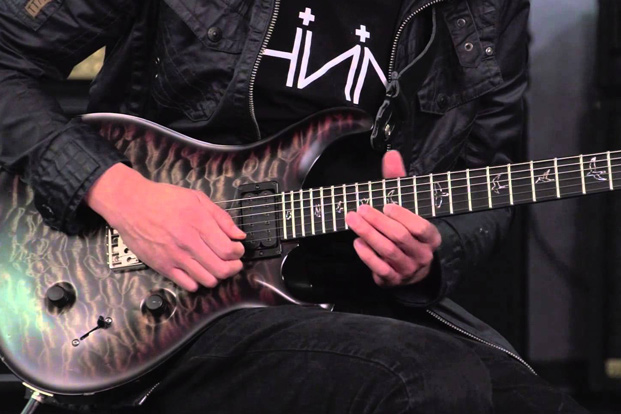Mark Holcomb Lesson: Devising the Unconventional, Acrobatic Guitar Riff in “The Bad Thing”

A Periphery riff that people often asked me about is the bridge section to “The Bad Thing,” from our 2015 album, Juggernaut: Omega.
I think of this as an “acrobatic” riff, in that its performance involves a great degree of jumping around the fretboard with speed and precision. I utilize many hammer-ons, pull-offs and open strings throughout it, which enable me to create the chaotic effect that the riff evokes.
I play this song in drop-B tuning (low to high, B A D G B E), transposed down a whole step, to what I call “drop-A,” so my strings are actually tuned, low to high, A G C F A D. But, as I do when using other transposed tunings, I prefer to think of and refer to the names of all the strings, notes and chords as if the tuning were not transposed.
So, in this case, I would think of just being in standard tuning with my low E string tuned down to B and would still think of and refer to a standard open D chord shape as “D,” even though it sounds a concert-pitch C chord in this tuning.
FIGURE 1 depicts the song’s eight-bar bridge riff. I start out in bar 1 utilizing notes from the B minor pentatonic scale (B D E F# A) and combine pull-offs, hammer-ons and slides to move quickly between 10th, ninth, seventh and open positions. Notice also the incorporation of the open sixth, fourth and first strings, which buy me time to make all these quick position shifts. Bar 2 makes brief reference to the IV (four) chord, Em, with notes derived from the E minor pentatonic scale (E G A B D).
In bar 3, I take the opening figure and shift its rhythmic phrasing one 16th note later, so that the initial note that fell squarely on beat one in bar 1 now falls on the second 16th note. At the very end of bar 3, I use a standard two-note power chord shape on the bottom two strings’ 12th and 14th frets. In this tuning, this two-note “grip” yields an octave instead of a root-fifth power chord. At the end of bar 4, I play the notes D#, D and C to provide a harmonically ambiguous way to get back to the initial melodic line.
Bar 5 is a repetition of bar 1, and bar 6 provides a slight twist on bar 2 with the substitution of a pair of Ds notes for the D and E notes played in bar 2. Bar 7 recalls bar 4, and the figure ends in bar 8 with the dissonant sound of the consecutive notes D#, D and C.
Another bizarre riff in this song is the pre-chorus, shown in FIGURE 2.
Two cool, twisted features here are the incorporation of behind-the-nut bends on the open sixth string in bars 1 and 3 and the shift from 4/4 meter to 3/4 in bar 2. Throughout the phrase, accents on the open sixth string alternate with the open fourth string, and the inclusion of the notes B, D, D# and C on the bottom string create a dissonant, atonal sound, which is what I was trying to achieve here.
Holcomb-Mania April 2016 FIGURE 1
Holcomb-Mania April 2016 FIGURE 2

Get The Pick Newsletter
All the latest guitar news, interviews, lessons, reviews, deals and more, direct to your inbox!









![Joe Bonamassa [left] wears a deep blue suit and polka-dotted shirt and plays his green refin Strat; the late Irish blues legend Rory Gallagher [right] screams and inflicts some punishment on his heavily worn number one Stratocaster.](https://cdn.mos.cms.futurecdn.net/cw28h7UBcTVfTLs7p7eiLe.jpg)
